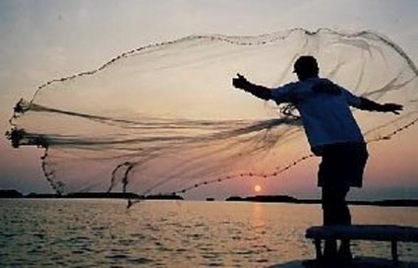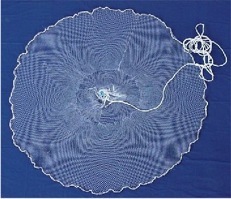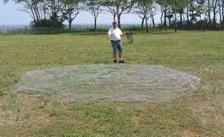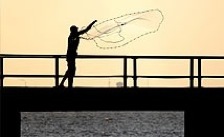
You always come home with fish if you’re a castnetter
Throwing Your Trouble Away
I love cast netting. I own five of them and when fishing rarely come home empty handed. I also never throw for bait: I go for the full-grown fish.
Here in Florida whatever saltwater fish I can catch with a line and hook I can catch with a cast net (check your local laws as they vary.) What is amazing is the attitude fishermen have about cast nets. Just as most folks never view weeds as food, most fishermen never view cast nests as something you catch big fish with. Frankly, that is all I catch with my cast nets.

Cast nets have weights all around the skirt
Beyond fishing, throwing a cast net is good exercise. I throw right and left handed to not only balance the workout but to throw longer. Toss 10 to 20 pounds a 100 times and haul it in against the waves and you get a workout. I’ll admit that learning to throw takes some practice, but it’s not hard and you can get good at it. I can put my favorite net any place within 25 feet with a lightning, low-to-the-water fastball throw. I can even toss one from a kayak. To have the best success you have to know where you are throwing and what you are throwing for.
There are five variables with cast nets. 1) The diameter, which is how far across the net, such as 6-foot, 10-foot, 12-foot. 2) The size of the mesh (1/4 inch, 1/2 inch, one inch), (3) The weight (actually the size of the weights.) The next variable (4) is where you are throwing: Surf, shallows, pier/breaker/bridge, boat. And the last variable (5) is what kind of fish you are fishing for.

A cast net is an elaborate funnel
For example, if I am fishing in deep water off a a good-sized boat for large fish I want a large cast net with heavy weights and a large mesh. The heavy weights and large mesh maximizes how fast the net drops through the water (and air) and hopefully it drops faster than the fish can swim down before you close the net. The large distance across increases my chances of success. Further, little fish you are not interested in can swim through the mesh and not get caught. And although it is a heavy I am not tossing as much out as down, just past the boat.
If I am in shallow water looking for fast fish I want a medium mesh, light weights (because it doesn’t have to drop far to hit bottom, and a light net so I can throw it very quickly and low to get the fish before they see the flying net.
In medium surf I want a large mesh, heavy weights, but a net that’s not too big across or I will quickly tire myself out. The mesh and weight let it drop fast in the churning, cloudy water. It also lets bait fish escape and holds the big fish well.
And if on occasion I want bait I use a small net with small mesh, and medium weights. In shallow water, it drops fast and the mesh is so small the little fish get caught.

Practice on a lawn so you can see your pattern
The biggest threat to a net is the bottom, and barnacles on rocks. If I am fishing off a bridge here is probably trash on the bottom that can snag the net. So I either keep the net from hitting the bottom or I use an old net I don’t mind loosing. If I am fishing from a rocky break water I try to find a rock that allows me to pull my net up vertically. Barnacles catch nets like superglue and they can cut your hands when you try to get it free. So on breakwaters you might also want to consider using a net you wouldn’t miss.
As said earlier, when I fish with my cast net I never come home empty handed. I always catch something, even if it’s just a blue crab off the sandy bottom or edible jellyfish. But usually it is the objet du jour: Pompano, Mullet, Whiting, Sea bass, Flounder, Sheepshead, Stingrays, Crabs, Conch, and various little fish have all been caught in my net. I even caught a small dolphin once by mistake. Yes, I let it go. On days when the hook and sinker guys are just throwing their bait away I am catching supper. I think that is what sold me on cast nets some 40 years ago when I was poor and hungry: They work.
As for practice… you throw on a lawn, so you can see how you did, whether your throw is opening the net. There are several throwing techniques and you will find one that suits you best. It’s a rather personal. Most throw only one way and as long as it gets the net open which way really doesn’t matter. Essentially one hand throws the net, the other hand spins it making the net flare like a dress on a spinning dancer getting maximum coverage when it drops. I would urge you after you learn to throw on one side, learn to throw on the other. It makes you better, more versatile, and you catch more fish.
An interesting fact: Fish, the experts say, have no memory so they don’t remember you just tired to catch them with a cast net. Fishermen are perhaps similar. One finds cast nets regularly as fishermen tend to leave them behind. And if you don’t find one, they’re not expensive.

Cast netters are optimists
I have learned that game wardens, usually in federal parks, are not up on cast net laws. They are surprisingly uninformed. For example: Seine nets used on shore locally are illegal (because they work oh so well.) Cast nets are legal but wardens think all nets are illegal. If you have checked out the law — and it’s legal — and a game warden is about to write you a citation, ask him to write down the specific law he thinks you are breaking, by statute number. They usually don’t know so they call headquarters and they usually don’t know either because it really doesn’t exist. After much posturing they let you go. You win one and keep your fish.


Very good article.
I have a few questions regarding the castnet.
What is your definition of weight (heavy, median and light)levels?
How to pull back your castnet after casting without lose of your fish?
How to catch mullet with castnet?
Are there any other nets for fishing in FL, which is legal?
Thank you so much.
James
1.5 pounds of weight per foot is standard. Total weight is the led and the netting. A ten foot cast nets weights about 15 pounds.
When you throw a net it opens and drops. When you pull it, it pulls from the inside causing the net to close.
Mullet live in relatively shallow water or near the surface of deep water. To catch them successfully you need a medium weight net thrown fast and as close to water surface as possible do they don’t see it coming. If you toss it in a high arch they will scatter before the net even gets wet.
Seine nets are now illegal in Florida because they are extremely efficient. A Port Canaveral once I watched two men with a 6 by 100 foot seine net. Using the jetty as one edge they deployed the net parallel to shore, curled the southern end to the beach then brought in the northern end back by the jetty. They had hundreds of fish, from prime to trash, sheeps head to small sharks.
I loved your artical and my husband and I agree with you on all counts. I have -rod n reeled my whole life, but hey, I like to eat fish and lots of it. No better way than a cast net. As to the light weight net for shallow water you mentioned, please tell me the manufacture so we can get a replacement for the one we have now. We have been trying to find a replacement net for mullet. We fish the canals for all sorts of fish but the heavy weighted nets like Joy Fish tear up the bottom and are a killer to cast. Thanks
that’s a hard one to answer as personal preferences and the weight one can accommodate varies.
Check Walmart online. they have a rather large selection. That’s where I got mine.
Article bought back memories of my grandfather teaching me to throw a castnet and the bounty of the Tomoka River Basin in Central Florida. One would never go hungry with a castnet…
Every 3 months I travel to the beach for a week to throw my cast net. I usually catch large mullet and medium pompano. I season them and cook them and they are delicious. A week well spent fishing and enjoying the wildlife of Florida’s beaches.
I have a 12′ castnet & I practice daily & I don’t know how to throw it.
After throwing a taco, I pull on the rope & then get to that ring w/ all those thick poly lines attached to it and pull that ring & all those lines up to the top of the rope. Then I grab a weight and grab another weight about 5 feet away from the weight I grabbed, one in each hand, and I try to swing the whole thing so it spins and spreads out like a frisbee, but, it just always ends up tacoing.
Wow, after trying out your advice I just threw a few good ones. You were right. Thanks. Didn’t catch anything with about 8 open throws but there’s hope. I’m anchored in about 40′ deep water. The bottom is pluff mud & it gets the net dirty quickly & it takes some time to clean. Maybe my net isn’t heavy enough. It’s a Betts, Tyzac, 12′ diameter, 1/2″. It says it’s for 2 to 5′ of water depth. It sinks pretty slow. Maybe I can add weights to it. I can’t anchor in shallow water. Got a 5.5′ draft & a full keel 35′ sailboat. I can use the dinghi though & go anywhere, but that shallow water has that pluff mud… I just saw another gator too. WOuldn’t want to fall over.
I finally caught my first fish w/ a castnet!! It was 2″ long. I used it as bait & caught a nice 14″ shrark. Yum!
Then I threw it some more & on the 2nd try I caught 4 x 5″ shad!
Then I threw it 10 more times & caught nothing. Same place. Don’t know why. I try to let it sink to different depths & experiment. But the more advice the better. Keep it coming. Speed of pull, how to throw it low & fast, how to use Tyzac.
In Florida it is legal to have a cast net 14 foot long with 1 inch mesh. There are three types of cast nets. Only two type are widely used. The Spanish cast net and the brail net are most often used. For catching mullet to eat, the one inch mesh is best.
I love to throw a cast net, however, I am still struggling to get more consistent results with my throws. Any advice?
What would you recomend for a castnet for shrimp. I am an adult male 6 ft 220lbs looking to cast inshore and bays in florida
Lots of weight and large holes.